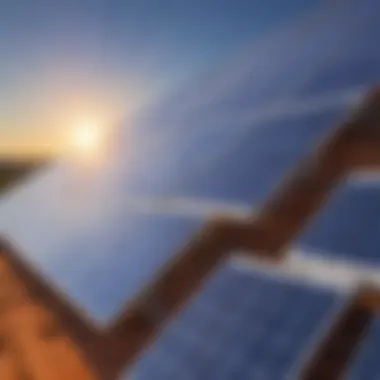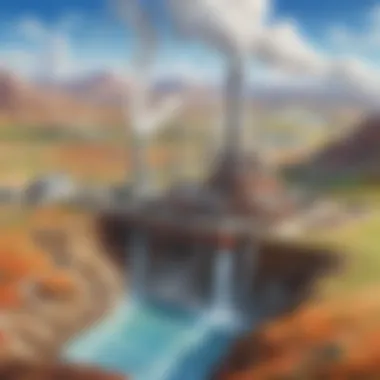Unveiling the Diverse World of Sustainable Energy for Young Science Enthusiasts


Science Fun Facts
As we set out on our expedition to understand alternative and renewable energy sources, let's begin with some intriguing science fun facts. Did you know that the Earth receives enough sunlight in an hour to meet global energy needs for an entire year? This astonishing fact underscores the potential of solar power as a sustainable energy solution. Meanwhile, wind energy, harnessed by wind turbines, has been utilized for centuries, with early windmills grinding grain and pumping water. These fun facts serve as a captivating introduction to the remarkable world of alternative energy.
Discover the Wonders of Science
In our quest to uncover the wonders of alternative and renewable energy sources, it is essential to explore various scientific concepts. Concepts such as photovoltaic cells converting sunlight into electricity or how wind turbines generate power from kinetic energy are crucial in understanding these innovative technologies. Educational videos and animations can further enhance comprehension, bringing complex scientific principles to life. By examining the real-life applications of solar and wind energy, young science enthusiasts can grasp the practical implications of these sustainable technologies.
Science Quiz Time
Engagement and learning go hand in hand, making science quiz time a valuable component of exploring alternative energy sources. Interactive quizzes can test knowledge on topics like solar panels' efficiency or wind energy production. Multiple choice questions encourage critical thinking by presenting various options to consider. Brain teasers and puzzles related to renewable energy add a fun challenge to the learning experience. Through gamification, children can actively participate in mastering the concepts behind sustainable energy solutions.
Science Experiment Showcase
To deepen understanding and foster a hands-on approach to learning, the science experiment showcase offers engaging experiments for young science enthusiasts. By following step-by-step instructions, children can conduct experiments exploring solar power and wind energy in a safe and controlled manner. A materials list ensures they have all the necessary supplies, promoting preparedness and organization. Safety tips and precautions provide essential guidance to ensure experiments are conducted responsibly and without risk. Through these interactive experiments, children can witness the practical applications of alternative energy sources firsthand.
Introduction
Welcome to the intriguing world of exploring alternative and renewable energy sources. This article aims to shed light on the importance of transitioning to sustainable energy solutions, especially for our younger science enthusiasts. Understanding the significance of embracing renewable energy sources is vital in our journey towards a greener and more sustainable future.
Understanding Energy Sources
Definition of Alternative Energy
Alternative energy refers to sources of power that are environmentally friendly and can be replenished. One key aspect of alternative energy is its sustainability - these sources can be harnessed without depleting natural resources. The unique feature of alternative energy lies in its ability to reduce our reliance on fossil fuels, hence mitigating the impact of climate change. The advantages of alternative energy are numerous, including lower carbon emissions and decreased environmental pollution.


Importance of Renewable Energy
The importance of renewable energy cannot be overstated in the pursuit of sustainable development. Renewable energy sources, such as solar and wind power, play a crucial role in diversifying our energy mix and reducing greenhouse gas emissions. One key characteristic of renewable energy is its ability to harness natural elements like sunlight and wind to generate power. The advantages of renewable energy include clean energy production, job creation in the green sector, and energy security for future generations.
Solar Energy
Solar energy stands out as a vital component in the realm of alternative and renewable energy sources. This clean and sustainable energy form has garnered significant attention for its immense potential to revolutionize our energy landscape. By harnessing the power of sunlight, solar energy offers a plethora of benefits, ranging from environmental sustainability to economic viability. The utilization of solar panels, which capture sunlight and convert it into electricity, epitomizes the essence of solar energy technology. These panels are designed with precision to maximize sunlight absorption and energy conversion efficiency.
Harnessing the Power of the Sun
Solar Panels Technology: Solar panels, comprising photovoltaic cells, play a crucial role in converting solar energy into usable electrical power. Their modular design allows for easy installation on rooftops or ground-mounted arrays, making them versatile and adaptable to various settings. The key characteristic of solar panels lies in their ability to generate electricity silently and without moving parts, ensuring minimal maintenance requirements. This feature positions solar panels as a reliable and durable choice for sustainable energy generation.
Solar Energy Benefits: The benefits of solar energy extend beyond mere electricity generation. Solar power promotes energy independence, reduces greenhouse gas emissions, and lowers electricity bills over the long term. A unique aspect of solar energy is its scalability, offering solutions that cater to individual households, commercial buildings, and even large-scale power plants. Embracing solar energy translates to reduced reliance on finite fossil fuels and a transition towards a cleaner and greener energy future.
Wind Energy
Wind energy stands as a pivotal component in the landscape of alternative and renewable energy sources, playing a crucial role in diversifying our energy mix. The harnessing of wind power has gained momentum as a sustainable solution to reduce our reliance on traditional fossil fuels. Wind energy presents a clean and abundant resource that offers a promising avenue for generating electricity with minimal environmental footprint. By delving into wind energy, young science enthusiasts can grasp the significance of tapping into nature's forces to meet our growing energy needs.
The Energy of the Wind
Wind Turbines Overview
Wind turbines serve as the embodiment of technological innovation and environmental consciousness. With their towering presence on landscapes, wind turbines capture the kinetic energy of the wind and convert it into electricity through rotating blades. The intricate design of wind turbines involves blade profiles, tower structures, and generator mechanisms working seamlessly to harness wind power effectively. The adaptability and scalability of wind turbines make them versatile options for both small-scale and large-scale energy generation projects. Embracing wind turbines enables us to capitalize on a perpetual energy source while mitigating greenhouse gas emissions, contributing to a cleaner environment.
Advantages of Wind Energy
The advantages of wind energy extend beyond mere electricity generation, encompassing a spectrum of environmental and economic benefits. Wind energy offers a renewable energy source that reduces our carbon footprint and lessens dependence on finite fossil fuels. Moreover, wind farms create job opportunities, boost local economies, and foster technological advancement in the realm of clean energy. The decentralized nature of wind energy decentralization minimizes transmission losses and enhances grid resilience, ensuring a more stable and sustainable energy infrastructure for future generations. By leveraging the advantages of wind energy, young minds can catalyze the transition towards a greener and more energy-efficient future.


Hydropower
Hydropower is a topic of immense importance within the domain of exploring alternative and renewable energy sources. This section sheds light on the utilization of water resources to generate clean and sustainable energy. By harnessing the power of flowing water, hydropower plays a pivotal role in the renewable energy landscape. The key aspect of Hydropower lies in its ability to provide a consistent and reliable source of energy, without the fluctuations associated with some other renewable sources. This reliability is crucial in meeting energy demands while maintaining environmentally friendly practices. Hydropower offers significant benefits such as being a renewable resource and producing electricity without releasing harmful emissions into the atmosphere.
Tapping into Water Resources
Hydroelectric Power Generation
Hydroelectric Power Generation is a central aspect of utilizing hydropower. This method involves the conversion of flowing water's kinetic energy into electricity through turbines. The key characteristic of Hydroelectric Power Generation is its efficiency in generating large amounts of electricity without relying on fossil fuels. This makes it a popular choice for sustainable energy production. One unique feature of Hydroelectric Power Generation is its ability to store water to meet varying energy needs, providing flexibility in energy supply. Its advantages include low operational costs and minimal greenhouse gas emissions, contributing positively to the goals of this article.
Environmental Impact
Addressing the environmental impact of hydropower is essential in understanding its overall implications. The key characteristic of the environmental impact is its role in altering aquatic ecosystems and affecting wildlife habitats. While hydropower is a clean energy source, its reservoirs can have negative consequences on river ecosystems. One noteworthy feature is the potential for increased methane emissions from reservoirs, impacting the atmosphere. Understanding these trade-offs helps in evaluating the advantages and disadvantages of hydropower, offering a holistic view in this article.
Geothermal Energy
Harnessing Earth's Heat
Within the realm of harnessing Earth's heat, the concept of Geothermal Power Plants plays a pivotal role in sustainable energy production. Geothermal Power Plants are infrastructure designed to convert the heat from the Earth into electricity through geothermal wells and steam turbines. This innovative approach allows for continuous power generation without relying on non-renewable resources. The efficiency and reliability of Geothermal Power Plants make them a compelling choice for sustainable energy initiatives. One key characteristic of Geothermal Power Plants is their ability to operate consistently, providing a dependable source of electricity. The reliable nature of Geothermal Power Plants makes them a prominent option for meeting the energy demands of the future.
Geothermal Power Plants
Moreover, the advantages of Geothermal Power Plants are vast and impactful. These plants produce electricity with low operational costs, making them economically viable for long-term energy production. Additionally, Geothermal Power Plants have a minimal environmental footprint, emitting significantly fewer greenhouse gases compared to fossil fuel-based power plants. The unique feature of Geothermal Power Plants lies in their ability to provide base-load power, meaning they can operate continuously, meeting the constant demand for electricity. This characteristic makes Geothermal Power Plants a valuable asset in the transition towards a sustainable energy landscape. Despite their many advantages, Geothermal Power Plants may face challenges related to location suitability and initial setup costs. However, the long-term benefits of utilizing geothermal energy outweigh these initial hurdles, positioning Geothermal Power Plants as a crucial element in the quest for clean and renewable energy sources.
Bioenergy


Bioenergy stands at the forefront of renewable energy sources, offering a unique perspective on sustainability and environmental consciousness. In the context of this article, bioenergy emerges as a critical element that plays a pivotal role in our quest for a greener future. Exploring bioenergy unveils a realm where power is derived from organic materials, such as plants and animal waste, presenting a novel approach to energy production. The significance of bioenergy lies in its potential to reduce reliance on traditional fossil fuels, aiming to mitigate the impact of climate change and foster a more sustainable energy landscape.
Power from Biomass
Biofuel Production
Embarking on the discussion of biofuel production reveals a fascinating process that transforms biomass into valuable energy sources. Biofuel production harnesses the energy content of organic materials, converting them into fuel that can power various aspects of our daily lives. One of the key characteristics of biofuel production is its versatility, as it allows for the utilization of diverse feedstocks, ranging from crops like corn and sugarcane to waste materials such as algae and agricultural residues. This adaptability makes biofuel production a popular and environmentally friendly choice for sustainable energy solutions, emphasizing the circular economy concept by utilizing renewable resources effectively.
Future Prospects
Innovations in Renewable Energy
Emerging Technologies
Exploring the realm of Emerging Technologies in renewable energy reveals a landscape rich in potential and promise for revolutionizing how we source power sustainably. These technologies encompass cutting-edge developments in solar, wind, hydro, and geothermal sectors, offering efficient solutions to our energy needs. One notable emerging technology is the advancement in energy storage systems, allowing for better harnessing and utilization of intermittent renewable sources like solar and wind. The integration of Internet of Things (IoT) devices and blockchain technology in energy grids is another breakthrough, optimizing energy distribution and consumption.
Role of Young Scientists
The Role of Young Scientists in the realm of renewable energy is pivotal for fostering innovation and driving sustainable practices forward. Young minds bring fresh perspectives and creative ideas to the table, accelerating the pace of technological advancements in the energy sector. By encouraging young scientists to explore renewable energy avenues, we empower them to become change-makers and problem solvers in the face of environmental challenges. Their involvement in research and development propels the industry towards greener, more efficient solutions. Collaborative projects and mentorships with experienced professionals enable a transfer of knowledge and expertise, ensuring a continuous cycle of innovation and improvement.
Conclusion
In dissecting the multifaceted realm of alternative and renewable energy sources tailored for young Science enthusiasts, the [Conclusion] segment emerges as the pillar consolidating the essence of this article. Central to this discourse is the crucial facet of underlining the imperative need for transitioning towards sustainable energy practices. By encapsulating the significance of advocating for renewable energy sources early on in one's scientific journey, young enthusiasts can cultivate a profound comprehension of environmental stewardship. In essence, the [Conclusion] segment serves as a pivotal cornerstone, instilling the principles of responsibility and innovation in the minds of burgeoning scientists, shaping a path towards a greener and more sustainable future.
Shaping a Sustainable Future
Eco-Friendly Energy Choices
Embarking on a profound exploration of the intricate web of energy alternatives, the [Eco-Friendly Energy Choices] come to the forefront as luminaries of sustainability. Within the ambit of this article, the ethos behind opting for eco-friendly energy choices transcends mere preference; it signifies a conscientious commitment towards curbing carbon emissions and mitigating environmental degradation. The quintessence of [Eco-Friendly Energy Choices] lies in their renewable nature, accentuating a cyclical framework of energy production that minimizes ecological footprint. This deliberate selection of sustainable power sources not only aligns with the overarching objective of this article but also heralds a paradigm shift towards greener energy practices curated for the betterment of our planet, one kilowatt at a time.
Call to Action
Vivid within the fabric of this narrative is the profound essence of the [Call to Action], beckoning young Science enthusiasts to embark on a journey of active participation in fostering sustainable energy paradigms. The heartbeat of this segment resonates with a clarion call to advocate for change, urging budding scientists to translate knowledge into action. At its core, the [Call to Action] pulsates with the urgency of embracing renewable energy solutions, not just as a theoretical concept but as a tangible roadmap towards a sustainable future. Enkindling a spirit of environmental stewardship, this rallying cry articulates a collective responsibility towards fostering innovation, driving young scientists towards tangible contributions in reshaping the energy landscape for generations to come.







